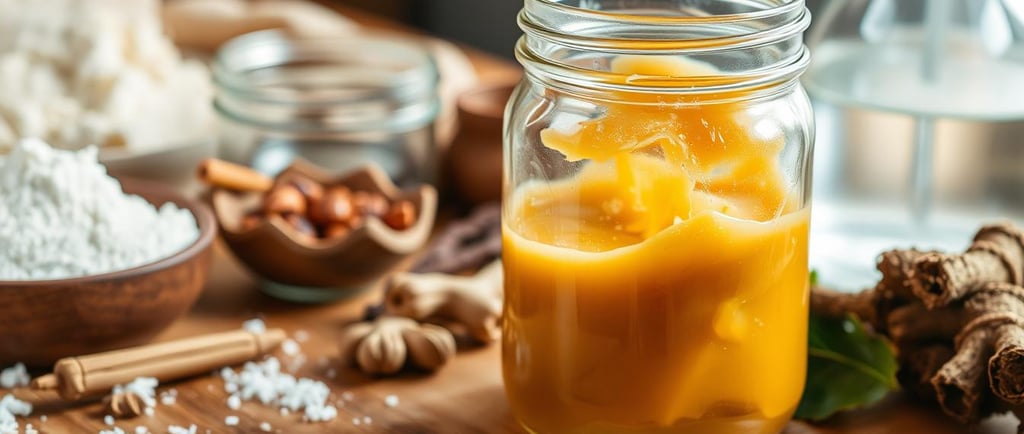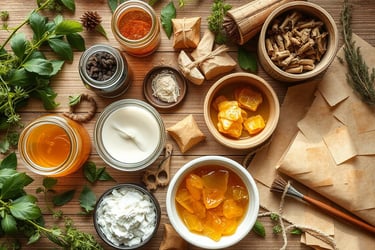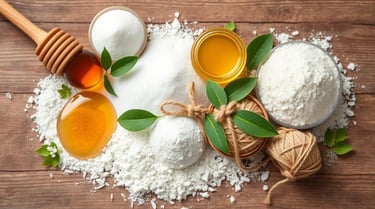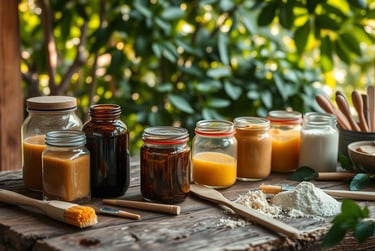Discover Natural Glues and Adhesives for Your DIY Projects
Discover the power of natural glues and adhesives for your DIY projects. Explore eco-friendly alternatives to traditional options.
PREPPING POSTS
Kathrine-Anne Hill
1/11/202512 min read


Discover Natural Glues and Adhesives for Your DIY Projects
I love exploring natural glues and adhesives. Making glue at home is easy and saves money. You can use flour, sugar, water, and vinegar to make a safe glue1. This method is better for the planet and our health compared to chemical glues1.
Natural glues have been around for 200,000 years. They include flour glue, or wheatpaste, used for bookbinding and wallpapering2.
Using natural glues improves our air and reduces waste. It's important to choose eco-friendly options. Homemade glue is much cheaper than store-bought, costing just pennies3. It's also fun and creative for DIY projects.
Key Takeaways
Natural glues and adhesives offer a non-toxic and eco-friendly alternative to traditional adhesives.
Making natural glue at home is simple and cost-effective, using ingredients like flour, sugar, water, and vinegar.
Natural glues and adhesives have been used for approximately 200,000 years, with various recipes and applications available.
Homemade glue can be made for "pennies" compared to commercial craft glue, which typically costs around $5 per bottle3.
Natural glues and adhesives can help reduce our environmental impact and improve air quality.
Using natural glues and adhesives provides a fun and creative way to approach DIY projects.
Understanding Natural Glues and Adhesives
Natural glues and adhesives are special because they are made from plants, animals, and minerals. They are good for the air and can break down easily4. This makes them popular for many uses.
They are also cheaper because they don't need synthetic bases4. Natural adhesives stick well and can handle a lot of force4. They work with many materials, like paper and packaging, because they are made from natural stuff5.
Some key benefits of natural adhesives are:
Improved air quality
Biodegradability
Versatility in applications
Cost-effectiveness
These advantages make natural adhesives a great choice for those who want to help the planet. The big market for corn starch shows how important natural adhesives are5.
Natural adhesives have been around for a long time. People have used tree sap and animal products to make them. As we keep making new things, choosing natural adhesives is a smart move for our planet.
The Environmental Impact of Traditional vs Natural Adhesives
Choosing between traditional and natural adhesives affects the environment a lot. Traditional adhesives come from petroleum and don't break down. This leads to a lot of waste and pollution6. On the other hand, biodegradable and eco-friendly adhesives are better for our planet.
Biodegradable adhesives help reduce waste and protect the environment. They're often made from plants and trees. These can grow back fast7. So, they're better than traditional adhesives for our planet.
Here are some key differences between traditional and natural adhesives:
Composition: Traditional adhesives are often made from petroleum-based materials, while natural adhesives are made from renewable resources.
Applications: Natural adhesives are often preferred for applications such as corrugated board, envelopes, and book bindings.
Environmental impact: Traditional adhesives can contribute to environmental waste and pollution, while natural adhesives offer a more sustainable solution.
Choosing between traditional and natural adhesives matters a lot for our planet. By picking biodegradable and eco-friendly adhesives, we can help the environment. This choice helps us move towards a greener future67.
Common Plant-Based Natural Adhesives
Exploring natural glues and adhesives is key. We find many plant-based options that are good for the planet. These eco-friendly adhesives help cut down on plastic waste and support recyclable packaging8. Starch and dextrin glues are cheap and can be made again, which is great8.
Tree Sap and Resins
Tree sap and resins have been used for ages as natural adhesives. They stick well and break down easily, which is good for the environment. Linseed oil-based glue from flax works fast, setting in about 10 minutes9.
Corn Starch Adhesives
Corn starch adhesives are a favorite, made from vegetable starches and water8. They're safe and break down, perfect for paper and packaging.
Rice-Based Glues
Rice-based glues are strong and last long. They're made from rice flour and water, making them natural and green. Before World War I, plant-based glues like soy were common. But after the war, they were replaced by adhesives made from oil9.
Animal-Derived Natural Binding Agents
For centuries, people have used animal-derived natural binding agents. They go back to around 2000 BC10. These adhesives come from animal parts like connective tissues, skin, or bones11.
They are a safe and natural choice for crafts and DIY projects. Hide glue, bone glue, and fish glue are some examples.
Hide glue is loved by woodworkers and craftspeople. It's reversible, doesn't creep, and pulls joints closed as it dries10. It's also used to make non-toxic glue and organic adhesives.
These adhesives are not just for woodworking. They're also used in bookbinding, paper making, and more12.
Animal-derived adhesives are good because they break down easily, are safe, and can be reused11. They're better for the environment than synthetic adhesives. As people learn more about non-toxic glue and organic adhesives, they'll want more of these.
In short, animal-derived natural binding agents are great. They're safe, break down easily, and are good for the planet. As more people look for organic adhesives, these agents will become even more important12.
Kitchen Ingredients That Work as Natural Glues
Kitchen items can be great for making sustainable glues instead of using traditional ones. For example, flour mixed with water makes a simple paste for crafts13. This glue is not only green but also simple to make and use.
Natural gums and pectin from fruits and veggies can make a strong adhesive14. You can also mix kitchen stuff like cornstarch, sugar, and water for homemade glue15.
Using kitchen items as glue is good for the planet. They're safe, break down easily, and are often cheap. This helps us make a greener future13.
Flour-Based Paste
Flour-based paste is a simple natural adhesive, made by combining flour and water, it forms a sticky mixture that hardens as it dries. This traditional glue has been valued for centuries for it's non-toxic, eco-friendly properties and is commonly used in craft projects like paper mache, collage and light construction projuects.
Mix 1/2 cup flour, 1/2 cup water, and a pinch of salt for a glue13.
Natural Gums and Pectin
Natural gums like gum arabic are derived from plant exudates and have been valued for centuries for their excellent film-forming and binding properties in adhesive applications. Similarly pectin--a naturally occuring polysaccharide extracted from fruits--offers a biodegradeable, eco-friendly option for creating strong bonds in both food products and sustainable packaging. Natural gums and pectin make a strong adhesive for paper, fabric, and more14.
For a gum-based adhesive--dissolve one part gum arabic in three parts warm water, stirring until the mixture is smooth. This transparent adhesive forms a flexible film ideal for delicate art projects like watercolor painting or calligraphy.
For a pectin-based adhesive--simmer apple cores or citrus peels with water until a gel forms, then strain and blend in a small amount of sugar to enhance its binding properties. Pectin-based adhesives are especially useful in culinary applications, such as sealing pastries or creating edible decorations.
Homemade Adhesive Recipe
Here's a simple, homemade recipe for a cornstarch-based adhesive that uses sugar and water:
Ingredients:
1 cup water (divided)
1/4 cup granulated sugar
2 tablespoons cornstarch
Instructions:
Prepare the slurry: In a small bowl, mix the cornstarch with 1/4 cup of water until it forms a smooth slurry with no lumps.
Dissolve the sugar: In a medium saucepan, combine the remaining 3/4 cup of water with the granulated sugar. Heat the mixture over medium heat, stirring constantly until the sugar is completely dissolved.
Combine and thicken: Gradually whisk the cornstarch slurry into the sugar solution. Continue to stir constantly as the mixture heats; within 3-5 minutes, it should begin to thicken and turn translucent.
Cool and store: Once the adhesive reaches a pudding-like consistency, remove the saucepan from heat and allow the mixture to cool to room temperature. As it cools, it will thicken further. Transfer the adhesive to an airtight container and store it in the refrigerator for up to one week.
This recipe yields a non-toxic, versatile adhesive ideal for paper crafts, light woodworking, and other creative projects. Adjust the ratios slightly if you need a thinner or thicker consistency for your specific application.
Best Applications for Different Natural Adhesives
Choosing the right natural glue for a project is key16. Natural adhesives fit into many categories. They are used in wood, food, paper, and construction16. For example, in construction, they are used for floor tiles and countertops16.
They are also used in woodworking, crafting, and home repair17. The cosmetic, agriculture, and furniture industries use them too17. Eco-friendly adhesives, like those from starch and gums, are popular16.
Animal sources, like albumin, are used in wood and food16. Vegetable sources, like gum arabic, are used in paper and cork16. Oils and waxes seal wood and metal16. Knowing about natural adhesives helps choose the right one for projects.
Natural glues are eco-friendly and versatile18. They are a top choice for many uses18. As research grows, we'll see new uses for natural adhesives17.
Safety Considerations When Making Natural Glues
Working with non-toxic glue and organic adhesives needs safety steps to avoid accidents19. Safety goggles are a must for everyone making natural glue. Wearing protective clothes is also a good idea when working with hot liquids.
Storing organic adhesives properly is key. Keep them in a cool, dry spot, away from kids and pets20. Knowing how long they last is also important. For example, Aleene's Original Tacky Glue stays good for up to 10 years if sealed well20.
Keeping glue and adhesives safe from kids and pets is vital. This stops them from getting into trouble20. By following these tips, you can have fun and stay safe while using natural glues.
Safety Precaution Importance Safety Goggles Required for 100% of participants19 Protective Clothing Suggested for 100% of activities involving hot liquids19 Proper Storage Essential for maintaining safety and shelf life20
Professional-Grade Eco-Friendly Adhesive Options
More people want products that are good for the planet. So, companies are making eco-friendly adhesives. These adhesives are made from plants and can be composted. They're great for packaging, woodworking, and textiles21.
These adhesives help cut down on pollution. They reduce waste in landfills and support a circular economy.
There are many eco-friendly adhesives out there. Water-based adhesives release fewer harmful chemicals. UV-cured adhesives don't have any chemicals at all21.
Companies like Bostik are making adhesives from bio-based materials. These materials have more bio-based carbon than fossil-based ones. They don't use petroleum at all22.
These adhesives cut down on carbon emissions. They also help use materials like plastic and paper more than once.
The prices of these eco-friendly adhesives vary. For example, ChemLink NovaLink 35 All-Weather Construction Sealant costs $11.06 per unit. AFM SafeCoat Caulking Compound costs $10.58 per unit23.
As more people look for sustainable products, companies are focusing on eco-friendly options. This can save money and make things more efficient in the long run.
Adhesive Type Price per Unit Eco-Friendly Features ChemLink NovaLink 35 $11.06 Water-based, low VOCs AFM SafeCoat Caulking Compound $10.58 Water-based, low VOCs Bostik Bio-Based Adhesive Varies Bio-based, compostable
Choosing eco-friendly adhesives helps reduce harm to the environment. It also supports a sustainable future for all of us.
Common Mistakes to Avoid with Natural Adhesives
Working with natural glues and adhesives needs careful attention. A big mistake is not preparing the surface right before applying the glue24. This can make the bond weak and lower the glue's effectiveness.
Another error is not following the right application methods for each glue type24. Some glues need a certain temperature or humidity to stick well. Wrong application can cause a messy finish or poor bonding24.
Here are some common mistakes to watch out for with natural adhesives:
Not reading the instructions carefully before applying the adhesive24
Not testing the adhesive on a small area before applying it to the whole project24
Not using the right amount of adhesive, which can cause a weak bond or waste24
Knowing these mistakes and taking the right steps can help you get a strong bond with natural glues and adhesives25. Also, using eco-friendly adhesives can lessen the environmental harm of your projects24.
Sustainable Packaging and Storage Solutions
Exploring natural adhesives leads us to think about sustainable packaging and storage. We look at sustainable glues and environmentally friendly adhesives in many uses26. shows green packaging can save money and cut down on pollution.
Some companies are using eco-friendly packaging. For example, Lush Cosmetics uses 100% recycled boxes for online orders27. BioPack's compostable tape breaks down in months27. These ideas show how sustainable glues and environmentally friendly adhesives can change the packaging world.
Here are some good things about sustainable packaging and storage:
Less waste and pollution
Lower greenhouse gas emissions
Save money by using materials wisely
Look better to customers and improve their experience
Choosing sustainable glues and environmentally friendly adhesives helps our planet26. talks about how making eco-friendly packaging is important. Let's all do our part to help the environment.
Tips for Maximizing Natural Adhesive Performance
To get the most out of natural glues and adhesives, consider the environment they'll be in. The best humidity for lash glue is 50-60%28. The ideal temperature is 21 to 25°C28. These conditions greatly affect eco-friendly adhesives.
When using natural adhesives, follow the application guidelines. Apply a thin, even layer of contact adhesive29. Make sure to align surfaces correctly before bonding29. Applying firm, consistent pressure helps create a strong bond29.
Some key things to think about for better natural adhesive performance are:
Temperature and humidity conditions
Surface preparation and cleanliness
Application technique and pressure
By considering these, your natural glues and adhesives will work their best. This ensures the results you want.
A guide to glues and adhesives offers insights into their differences and uses. Knowing this helps you choose the right natural glues and adhesives for your projects.
Conclusion: Embracing Natural Solutions for a Sustainable Future
The world of natural glues and adhesives is full of eco-friendly options. By choosing biodegradable adhesives and environmentally friendly adhesives, we help the planet. We also get many benefits from these natural solutions30.
Tree sap and resins bond very well, and flour-based pastes are very versatile. These natural adhesives work well for many things31. They help reduce waste, make air cleaner, and even increase property value3130.
Looking ahead, we'll see more focus on sustainable building and eco-friendly choices. Using natural adhesives helps us make a better world3130.
Related Posts:
Learn These UncommonBushcraft Skills for Outdoor Mastery
FAQ
What are natural glues and adhesives?
Natural glues and adhesives come from organic, sustainable materials. They include plant-based or animal-derived ingredients. These glues are better for the environment than synthetic ones.
What are the benefits of using natural adhesives?
Natural adhesives improve air quality and reduce environmental harm. They use non-toxic, organic materials. They're great for DIY, crafting, and eco-friendly projects.
What types of natural glues and adhesives are available?
You can find many natural glues and adhesives. There are plant-based ones like tree sap and corn starch. Animal-derived options are also available. Plus, you can make your own from kitchen items like flour and natural gums.
How do natural adhesives compare to traditional adhesives in terms of environmental impact?
Traditional adhesives have synthetic chemicals and harm the environment. Natural adhesives are biodegradable and better for the planet.
What are the safety considerations when using natural glues?
It's key to store natural glues right and know their shelf life. They're often safe, but follow safety rules for best use.
What are some common mistakes to avoid when using natural adhesives?
Don't skip surface prep or use wrong techniques. Temperature and humidity matter too. Good practices ensure your projects work well.
How can I maximize the performance of natural adhesives?
Think about temperature, humidity, and how you apply them. Follow the maker's advice and try different glues. This helps find the best one for you.
Source Links
Homemade Natural Glue ( Simple Recipe & Useful Tips) - https://sustainableecho.com/homemade-natural-glue/
20 Ways To Make Homemade Natural Glue - Sew Historically - https://www.sewhistorically.com/20-ways-to-make-homemade-natural-glue/
How to Make Glue - https://onelittleproject.com/how-to-make-glue/
Natural Versus Synthetic Adhesives and Products | Bond Tech - https://www.bond-tech-industries.com/blog/which-is-best-natural-or-synthetic-adhesives/
Natural Glues for Industrial Applications - https://blog.lddavis.com/natural-glues-for-industrial-applications
Solving stickiness sustainably - https://www.purdue.edu/newsroom/2023/Q3/solving-stickiness-sustainably
Is Glue Sustainable? - https://www.treehugger.com/what-glue-made-4847390
Eco-Friendly Glue | Plastic-Free Biodegradable Adhesives - https://www.lddavis.com/products/eco-friendly-glue/
Glue Made of Plants - https://news.lafayette.edu/2019/09/29/glue-made-of-plants/
Animal glue - https://en.wikipedia.org/wiki/Animal_glue
Bookbinding Glue | Learn about bookbinding adhesives & uses - https://blog.papercraftpanda.com/know-the-difference-bookbinding-glue/
What are adhesives? - https://www.anglo-adhesives.co.uk/blog/what-are-adhesives/
5 Ways to Make Glue - wikiHow - https://www.wikihow.com/Make-Glue
5 Easy Homemade Glue Recipes - https://www.thoughtco.com/homemade-glue-recipes-607826
3-Ingredient Homemade Glue - https://happyhooligans.ca/homemade-glue/
Adhesives: Applications and Recent Advances - https://www.intechopen.com/chapters/57763
Bio-based and bio-inspired adhesives from animals and plants for biomedical applications - https://pmc.ncbi.nlm.nih.gov/articles/PMC8777159/
WHAT ARE THE DIFFERENT TYPES OF ADHESIVE & THEIR APPLICATIONS? - https://www.kohesibond.com/what-are-the-different-types-of-adhesive-their-applications/
Activity – Making Glue at Home - American Chemical Society - https://www.acs.org/education/celebrating-chemistry-editions/2020-ncw/making-glue.html
Learn All About Glue's History and Interesting Facts - https://aleenes.com/blogs/projects/everything-you-need-to-know-about-glue-before-using-our-glue-guide?srsltid=AfmBOopVUShH6A6gTWJOYQUoWbzZskFZw36u14AXC-TjFWPxCiEue42n
These Six Sustainable Adhesive Types Play a Big Role in Sustainable Packaging - https://www.adhesivesmag.com/articles/100375-these-six-sustainable-adhesive-types-play-a-big-role-in-sustainable-packaging
5 Adhesives to Help Enhance Sustainability | Bostik US | Bostik US - https://www.bostik.com/us/en_US/blog/post/2018/9/5-types-of-sustainable-adhesives-to-know-about/
Caulks, Sealants & Adhesives - Non-Toxic, Effective - https://www.greenbuildingsupply.com/All-Products/Paints-Coatings-Caulks-Sealants-Adhesives
Woodworking Adhesives for Manufacturing and Crafts: Explained - https://www.anglo-adhesives.co.uk/blog/woodworking-adhesives-for-manufacturing-and-crafts-explained/
Eco-friendly Packaging Company | Sustainable Packaging | Packmile - https://www.packmile.com/
8 Sustainable Packaging Solutions to Solve the Waste Dilemma | Earth.Org - https://earth.org/sustainable-packaging-solutions/
The Ultimate Guide to Maximising Lash Retention - https://lashjungle.com/blogs/news/the-ultimate-guide-to-maximising-lash-retention
Unleash the Strength of Contact Adhesive Glue Mastery - https://superbond.co.in/mastering-the-art-of-bonding-the-power-of-contact-adhesives-glue/
Transparent adhesives are versatile materials for industries and everyday applications - https://www.linkedin.com/pulse/transparent-adhesives-versatile-materials-industries-everyday-elsa-lu-zicoe
Sustainable building for a better tomorrow: 7 advantages of green construction - PlanRadar - HR - https://www.planradar.com/au/sustainable-building-7-advantages-green-construction/








